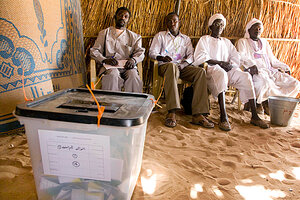Sudan election: Can art keep the country together?
As voters cast their ballots in the first Sudan election in 24 years, a group of artists are campaigning against a growing secession movement. From Sudan's top painters to a homeless man, they offer images of unity.

In this photo, election observers watch a ballot box at a polling station in Zam Zam camp for internally-displaced persons, in Darfur, Sudan on Sunday.
Albert Gonzalez Farran/UNMIS/AP
Khartoum, Sudan
This week's Sudan elections – the first to be held in 24 years – will set the stage for a landmark referendum, in which southern Sudanese will have the right to decide whether to remain a part of the country they fought a civil war with, or to go their own way as a deeply impoverished but free, separate country.
With the unity of Sudan at stake, many Sudanese artists think that politics has become too important to be left to the politicians.
Polls regularly show that southerners seem inclined to vote for secession, a fact that saddens artists like Khalid Hamid, who view their country’s diversity as one of its main strengths.
“I’m feeling guilty that I didn’t realize that we are at the point of separating,” says Mr. Hamid, one of Sudan’s top painters, and one of the founders of a new artists' collective called Sudan Unite. “But our diversity is our strength as a nation. We can make a Sudan like we dream of.”
The group has recently begun a campaign to paint public areas with images that emphasize Sudan’s rich cultures – a blend of Arab and African; Muslim, Christian, and animist – each strong and proud, but able to coexist.
Resolutely apolitical, determinedly optimistic, and secular in outlook, the artists and intellectuals of Sudan Unite say they support the right of southern Sudanese to vote for separation if they choose. But separation, they say, would be a terrible loss for Sudan, and would leave both north and south much weaker and poorer.
Rare message of optimism
Even though a 2011 referendum will follow close on the heels of this week's vote for president and parliament, which have already exposed deep divisions between the once-warring parties of the North and South of Sudan, the members of Sudan Unite refuse to believe that their efforts are coming too late.
That's why they are taking their message to the streets, painting murals, holding public impromptu concerts, and reminding Sudanese of all religions and cultures of how much they all have in common.
“We decided to take action, not to stop the people of the south to express their desire for separation, but to show the beauty of all the people of Sudan, and the respect for all the cultures of Sudan,” says Sabry Babikar, a researcher in international law, and co-founder of Sudan Unite.
He points to the rich collection of Sudanese around him: northern Muslims, Christian southerners, sipping tea in the late afternoon, in front of a long wall of murals depicting the various cultures of Sudan.
“It’s the politicians who say we can’t live together,” he says. “But here we are, all sitting together.”
Homeless man paints powerful message
Here on Comboni Street, the Sudan Unite message comes out loud and strong. There is a life-sized portrait of a child – painted by homeless children with paint given them by Sudan Unite – one leg painted with the flag of the southern based liberation party SPLM; the other leg is painted with the flag of the northern ruling Islamist party, the National Congress Party.
Another painting by Hamid features a Noah’s Ark full of people, some in the garb of southern Dinkas, others in the clothes of western Darfuris; some dressed as Arabs, others dressed as Nubians from the north.
Some paintings, like Hamid’s, are technically impressive, while others are simple but powerful in their message. One homeless man, given paints by Sudan Unite, painted a Sudanese flag, ripped in half, but painstakingly stitched back together.
British role in historical division
The Ottoman empire unified the North and South of Sudan for the first time in the 1840s, says Jaffar Taha, a historian at the University of Khartoum and a member of Sudan Unite. But it was the British who specifically forbade northern Sudanese Muslims from entering the then-animist south, and thus created the cultural divisions that still exist today, he says.
“When the British said let the Nile be British, we inherited the problems of present-day Sudan,” says Dr. Taha. “But then, since liberation, what did we do as nationalists to solve that problem? We, the generation of independence, failed to solve the big problems of the unity of our country, and now we are paying the price.”
A lesson from Sudan's donkeys
For Hamid, the answer to Sudan’s problems is for Sudanese to stop acting like donkeys.
Hamid knows his donkeys. As an artist, he’s practically obsessed by them, and donkeys are a kind of theme that pass through landscapes that deceptively look like simple Sudanese country scenes, but in fact are a kind of social commentary.
He lays out a dozen brand-new watercolor paintings on the dusty street in front of a sidewalk cafe full of students. The students walk out to view the paintings of a man they all know. Hamid is about to lay one painting right into a mud puddle, and the students start shouting “No, no, no, no!" A mischievous grin forms on his face.
“Who is guiding, the man or the donkey?” he asks, pointing to a lovely watercolor of a man whipping a donkey along in a donkey-cart. “I don’t want to be like a donkey, without knowing the meaning of yes and no, without knowing what I’m carrying on my back. I have my own vision of life, my own dignity, my own respect.”
